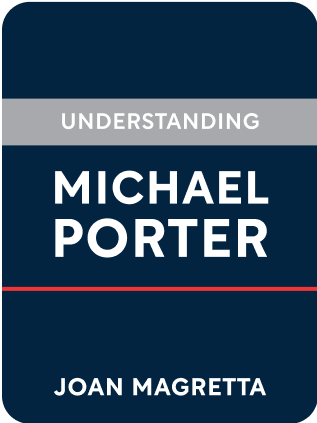

This article is an excerpt from the Shortform summary of "Understanding Michael Porter" by Joan Magretta. Shortform has the world's best summaries of books you should be reading.
Like this article? Sign up for a free trial here .
Do you know how to do an industry analysis using Michael Porter’s five forces model?
Here’s how you can do your own industry analysis in 5 simple steps. This will help you understand what industries are attractive or not for investment, and how well a company will fare in the industry.
How to do An Industry Analysis
The Five Forces are used to study the profitability of any industry, and you can learn how to do porter’s five forces analysis on your own. Michael Porter outlines the process on how to apply them to analyze an industry, and you can use them to learn how to do an industry analysis.
1. The first step in learning how to conduct an industry analysis is to define the industry by its product scope and geographic scope.
- Rule of thumb: Where there are large differences in forces, you are likely dealing with distinct industries. Each industry will need its own strategy.
- Product scope
- Motor oil used in consumer cars is different from those used in trucks. The latter involve corporate buyers and use different selling channels.
- Geographic scope: global, national, regional
- Buyers may be very different across geographies, even with the same product.
2. Identify the players comprising each of the Five Forces. Segment them into groups.
3. Understand the drivers of each force. Which are strong? Which are weak? Why?
4. Step back and understand the industry as a whole.
- Which forces determine profitability? Rarely are all five forces equally balanced.
- Where are the more profitable companies positioned in relation to the Five Forces?
- How do your results measure up to the industry’s level of profitability?
5. Study recent changes and predict future changes for each force.
- How are the forces trending?
- How can your competitors influence industry structure and shift the Five Forces?
- Each of your Five Forces is its own industry. Within each industry represented by a force, how will competitors or new entrants change that industry’s structure? (For example, your substitute’s industry may face increased competition from incumbent rivalry.)
6. The last step in knowing how to conduct an industry analysis is to ask: where will you position yourself relative to the Five Forces? Where the forces are weakest? Where change will open new opportunities? Can you reshape the industry structure?
The point of Five Forces isn’t just to declare an industry attractive or unattractive; it’s also to gain insight about where industry profitability is and how it will change. In short, it’s about learning how to do an industry analysis.
Practically for you, it also helps you understand your performance relative to the industry, and how you should overcome forces to capture more of the value you create. You can apply your knowledge of how to do porter’s five forces analysis to any business.
Analogy: good strategies are shelters in a storm. Five Forces analysis forecasts the weather. It’s important to know this to understand how to conduct an industry analysis.
Points About Industry Structure
Industry structure is surprisingly stable over time, even with the introduction of new products and new technologies. New products are introduced and companies come and go, but the overall profitability of an industry changes relatively slowly.
The same company can require different strategies in different markets.
- In the US cement industry, large powerful buyers bargain for low prices. In Mexico, the majority of revenues come from small individual customers, served by large producers.
Leaders in an industry can shape the industry by leading competition away from price.
- For example, Sysco moved the basis of competition for food suppliers away from price and toward useful services, like private label to neutralize suppliers. They provided services like inventory management and nutrition planning. This shifted competition away from price alone, and the industry became more attractive.
Misleading Predictors of Profitability
Another part of knowing how to do porter’s five forces analysis is wading through misconceptions. A Common perception correlates certain attributes of industries with profitability. For instance, high-tech industries seem large and profitable, and so people often associate technology with profitability.
Porter argues these associations are not predictive in themselves – rather, the changes need to be analyzed by their impact on the Five Forces.
Examples of misleading associations include:
- High growth vs low growth
- Growth is no guarantee the industry will be profitable.
- All forces can change with growth. Growth might put suppliers in the driver’s seat, or new entrant competition becomes fierce before entry barriers are established.
- Technology
- Can raise costs if all competitors adopt it
- Can decrease profitability by increasing buyer power, for instance by enabling price shopping
- Regulation
- Should be mapped to Five Forces. The specific regulation can affect forces differently – it can increase the barrier to entry for new entrants (e.g. in regulation that requires licensing), or increase competition among rivals (e.g. in anti-trust regulation), or increase the bargaining power of suppliers (e.g. in regulation promoting workers’ rights).
Exercise for How to Do an Industry Analysis
Study the Five Forces in your industry to understand its overall profitability. Discover which forces influence your success the most, and use this exercise to discover how to do an industry analysis.
Who are the buyers in your industry? Are they concentrated or fragmented? Do they have high or low switching costs to competitors? Are they price sensitive? Overall, how strong is this force?
Who are the suppliers in your industry? Are they concentrated or fragmented? Does your industry represent a large portion of their sales? Do you have high switching costs to change suppliers? Overall, how strong is this force?
Who are the substitutes in your industry? Do they offer a better price-to-performance ratio? Which segments of customers do they serve adequately? Which segments do you serve much better than substitutes? Overall, how strong is this force?
Who are the competitors in your industry? How easy is it for your buyers to switch to your rivals? Is the industry fragmented or concentrated? How much of your industry competition is based on price, rather than differentiated value? Overall, how strong is this force?
What is the threat of new entrants in your industry? What barriers to entry limit the arrival of new entrants? What incumbents from neighboring industries might enter your industry? How do you defend against new entrants? Overall, how strong is this force?
While learning how to do an industry analysis effectively can be difficult, it’s a skill work practicing. Reference this guide anytime you have questions about how to do an industry analysis.

———End of Preview———
Like what you just read? Read the rest of the world's best summary of Joan Magretta's "Understanding Michael Porter" at Shortform .
Here's what you'll find in our full Understanding Michael Porter summary :
- How Porter's famous Five Forces help you analyze every industry
- How IKEA, Southwest Airlines, and Zara have ironclad, defensible strategies
- Why the best companies reject opportunities to focus on what they know






